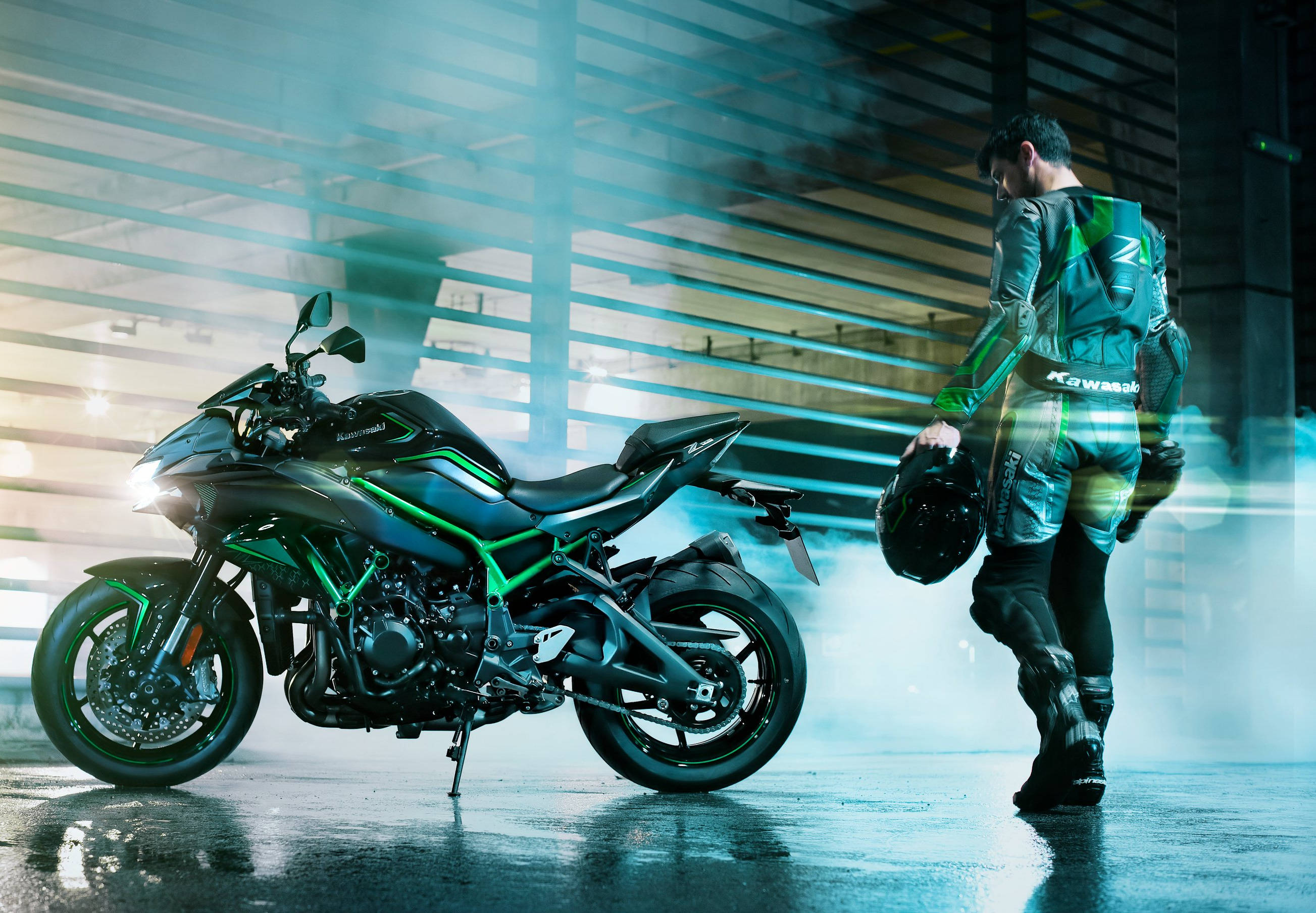
Kawasaki has supplemented the scant details previously released on the 2020 Z H2 Supercharged naked bike. We now have full specifications for the U.S. model, which you can find here. These specs include, among others, fully adjustable suspension (compression, rebound and spring preload) front and rear and a claimed 527 pound curb weight (with all fluids, including 5 gallons of fuel).
Here is the full, new press release from Kawasaki, together with several new photos. One illustration shown below demonstrates the increase in low-end and mid-range power of the new Z H2 versus the supercharged Ninja H2 SX sport tourer released a couple of years ago.
Kawasaki’s legacy of creating motorcycles that have unrivaled performance, excitement, and Sugomi™ styling continues with an all-new flagship model of the Kawasaki Z line of naked motorcycles, the 2020 Z H2. With the arrival of the hypernaked Z H2 and its powerful, balanced supercharged engine, the second chapter of Kawasaki’s Z history is about to begin, marking the beginning of a new era.
Featuring a powerful and balanced supercharged engine, performance can be enjoyed across its entire rev range while still offering superb fuel efficiency. The innovative new Z H2 offers refined naked styling, a high level of handling and comfort, and the latest technology worthy of the new Z series flagship model.
The Z H2 was developed to deliver the power you desire on-demand, a chassis that delivers superb maneuverability while harnessing the engine’s incredible power, comfort that enables you to ride for long distances, and a host of advanced features designed for maximum functionality. The Kawasaki Z H2 is a truly unique motorcycle and offers a glimpse of the future.
Highlights of the 2020 Z H2
- Powerful 998cc Balanced Supercharged Engine
- Dog-Ring Transmission
- Specially Designed, Lightweight Trellis Frame
- High-Performance Showa Suspension Components
- Brembo® Monobloc Brake Calipers
- Aggressive Sugomi™ Styling and Minimalist Bodywork
- LED Lighting
- All-Digital TFT Color Instrumentation
- Smartphone Connectivity via RIDEOLOGY THE APP
- State-of-the-Art Electronics (IMU Electronics Package, Integrated Riding Modes, Power Mode, KTRC, KCMF, KIBS, KLCM, KQS, Electronic Cruise Control, Assist & Slipper Clutch)
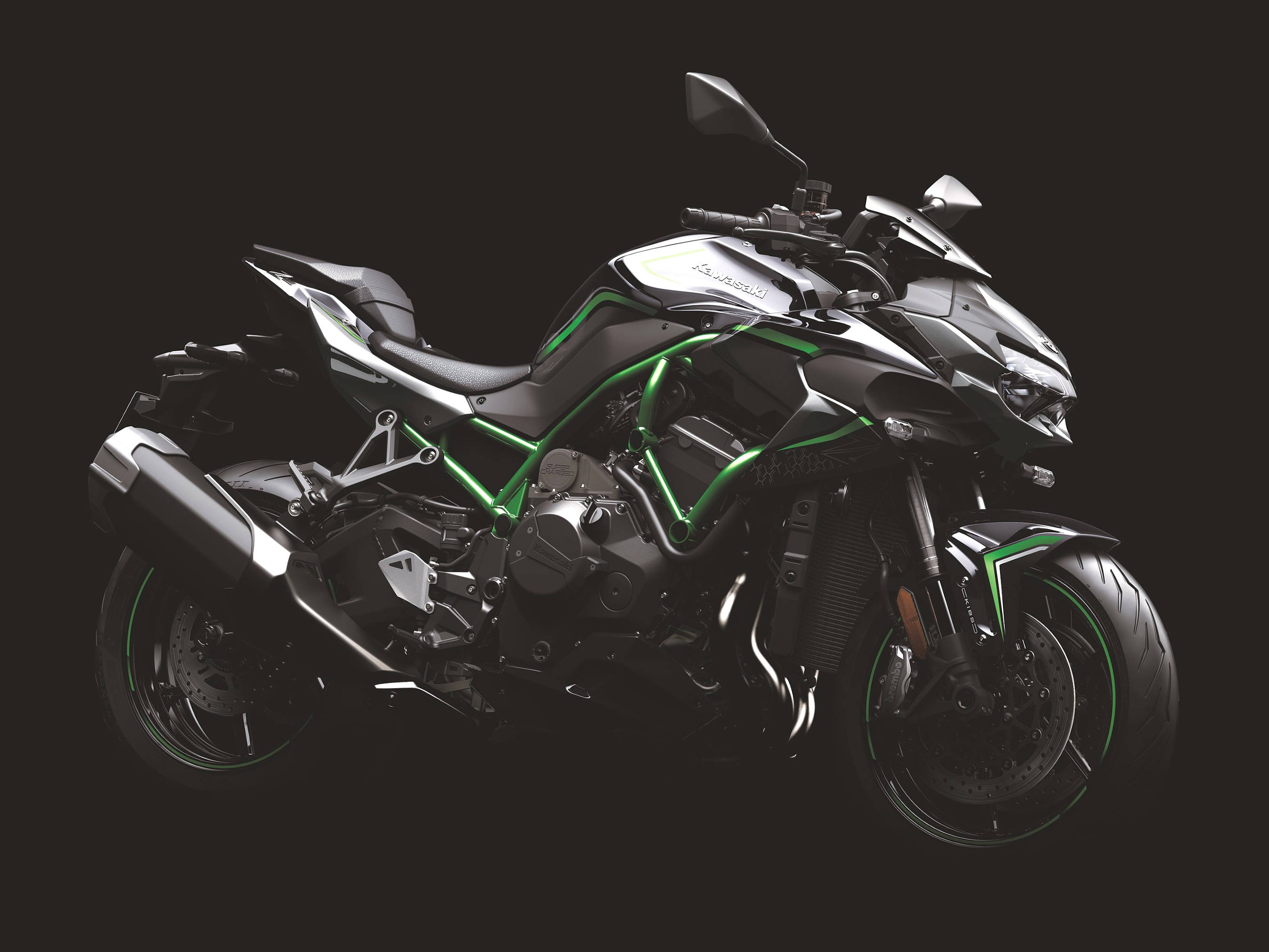
Engine
The Z H2’s Balanced Supercharged Engine is the product of Kawasaki Group technology, designed in-house not only by the Motorcycle and Engine Company, but also with collaboration from the Aerospace Systems Company, Energy System and Plant Engineering Company, and Corporate Technology Division. Kawasaki created a supercharged engine with high output, yet manageable power delivery. The water-cooled DOHC 4-valve parallel 4-cylinder 998cc supercharged engine of the Z H2 has been tuned to showcase high-performance throughout the rpm range. Its wide powerband creates optimal low-mid range torque for light handling and all out supercharged performance on the top end. Smooth acceleration in the low to mid rpm range was achieved by shortening the second reduction ratio and optimizing the valve timing. In the chamberless exhaust system, an increase in the tube length of the manifold assembly further improves the output in the low to mid rpm range. Where torque is more apparent, in the low to mid rpm range, the supercharged engine emphasizes easy-to-handle throttle response and smooth acceleration, while in the high-rpm range as the speed increases, the power from the supercharged engine is brought to the forefront. The Z H2 also features a ram air intake. The air duct provides a clean path for air flowing linearly from the ram air intake to the supercharged engine, contributing to higher performance.
The street specific Z H2 supercharger design and tuning were developed by Kawasaki Heavy Industries, Ltd. (KHI) showcasing the in-house knowledge of forced induction engine performance. The supercharger’s high efficiency and minimal heat gain meant an intercooler was unnecessary, allowing savings in both weight and space. The supercharger is located centrally in the best position to evenly distribute the compressed air to all four cylinders.
The supercharger is driven by a planetary gear train, which runs off the crankshaft. The gear train increases the impeller speed up to 9.2x the crank speed (1.15x step gear with an 8x planetary gear).
Transmission
The Z H2 uses a dog-ring transmission that has been developed through feedback from the Kawasaki Racing Team and utilizes optimal gear ratios for street performance. Rather than shifting the gears into place, the gears in this configuration stay in place, with the lightweight dog-rings moving to engage the gears. This design allows the shifting effort to be lighter and shorter for quicker acceleration.
Assist & Slipper Clutch
Complementing the transmission is an Assist & Slipper clutch, race-inspired technology that offers both a back-torque limiting function as well as a light feel at the lever.
The Assist function is noticed by the lighter pull at the clutch lever, helping to reduce rider fatigue especially in stop and go traffic situations.
The Slipper function is noticed when excessive engine braking occurs as a result of quick or accidental downshifts. The slipper cam comes into play, forcing the clutch hub and operating plate apart, which relieves pressure on the clutch plates to reduce back-torque and help prevent the rear tire from hopping and skidding.
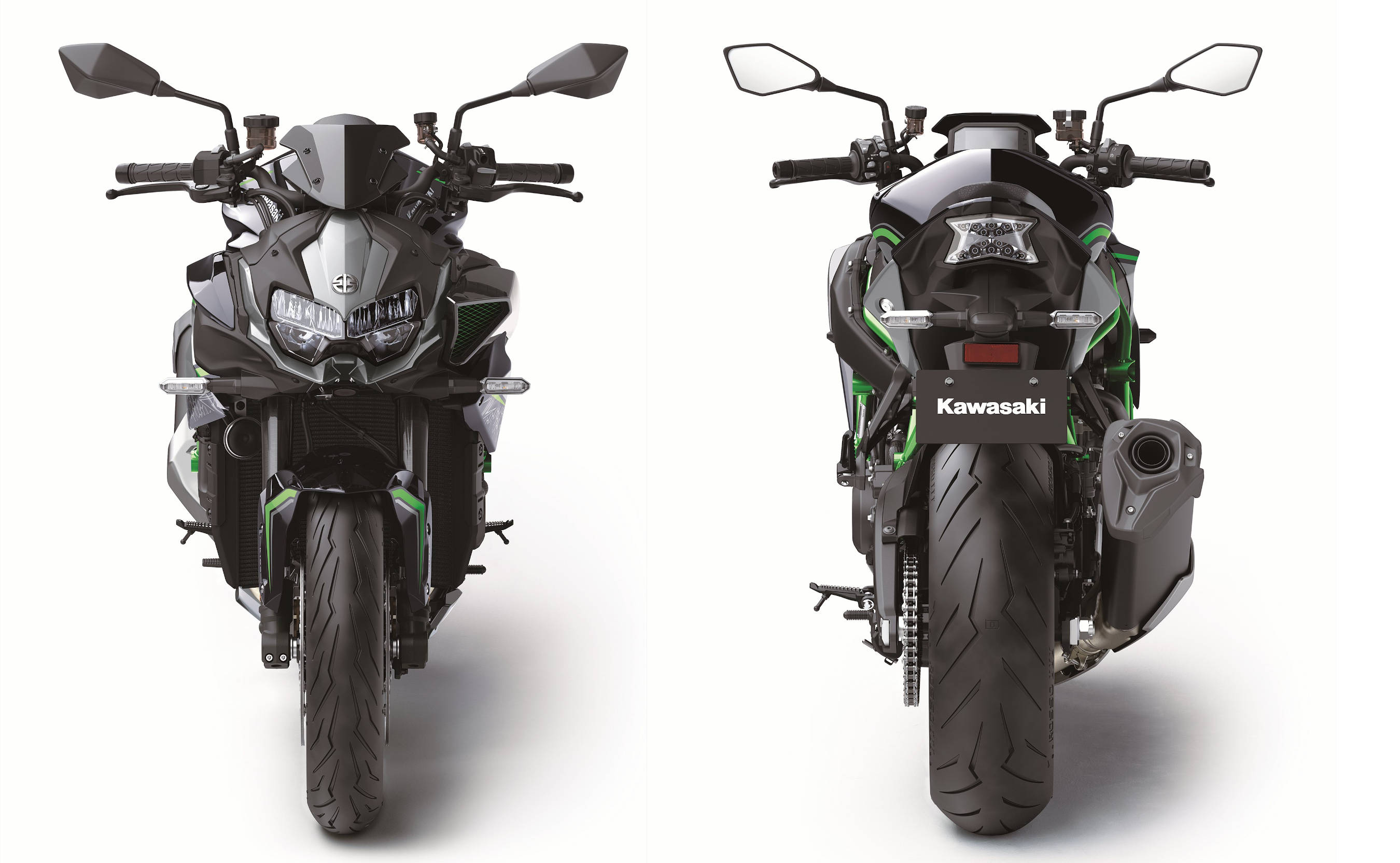
Chassis
A specially designed, lightweight trellis frame delivers both light handling and excellent straight-line stability. The chassis offers excellent maneuverability while harnessing the massive supercharged power of the Z H2 engine. The compact naked model frame has a high-level of balance between flexibility and toughness so that you can ride on a variety of roads.
The new high-tensile steel frame utilizes wheelbase and caster angle dimensions that showcase the light, sporty handling unique to the Z H2. By achieving the desired riding position and center of gravity, the frame and suspension of the Z H2 performs well across a range of speeds.
A double-supported style of swingarm was chosen for the Z H2, similar to those found on Kawasaki supersport models. It offers the high rigidity and lightweight construction necessary for high performance. The swingarm mounting plate is located on the back of the engine, enabling it to play the role of a cross member in the frame, contributing to rigidity and weight reduction.
Suspension
Complementing the chassis design, the Z H2 motorcycle is equipped with the Showa SFF-BP (Separate Function Fork – Big Piston) fork. Combining the concepts of Showa SFF and BPF, this advanced fork offers both racetrack performance and everyday usability.
The Showa SFF-BP offers smooth action at the beginning of the stroke that contributes to excellent composure under braking. The large-diameter damping piston is much larger than what is found in a cartridge-type fork of the same size. The result is greater control as the fork begins to compress and a very calm attitude change as vehicle weight shifts forward when reducing speed, offering greater chassis stability on corner entry. The settings can be adjusted according to the rider’s size and the riding conditions.
The rear is held up by a Uni-Trak® swingarm system and Showa shock. This combination ensures performance in all speed ranges and achieves a strong withstanding force by maintaining hold in the suspension stroke even under high-adrenaline riding.

Brakes & Wheels
The Z H2 pursues ease of handling from low and medium speeds up to high speeds, and for that reason, a high performance brake system is required. On the front, Brembo monobloc calipers are used and consist of a highly rigid one-piece structure that is machined from a cast aluminum block, boasting a strong braking force. Radially mounting the caliper provides even higher levels of performance.
Nissin master cylinders provide excellent functionality suitable to the characteristics of the Z H2 by applying Kawasaki’s unique settings. Deceleration can be controlled from various speed ranges as well as controlling the starting point for changing body posture when needed.
The lightweight 17” wheels are equipped with Pirelli Diablo Rosso III tires, front and rear. The front tire is a 120/70ZR17 M/C 58W; the rear tire is a 190/55ZR17 M/C 75W.
Ergonomics
A relaxed riding position has been created by a combination of an upright handlebar shape and a seat with an optimized base plate and cushion thickness. This design provides a high degree of freedom for riding posture and low vibration, allowing for a pleasant and comfortable ride. Adding to the Z H2 motorcycle’s comfort and strength is a fat-type handlebar and handle switches.
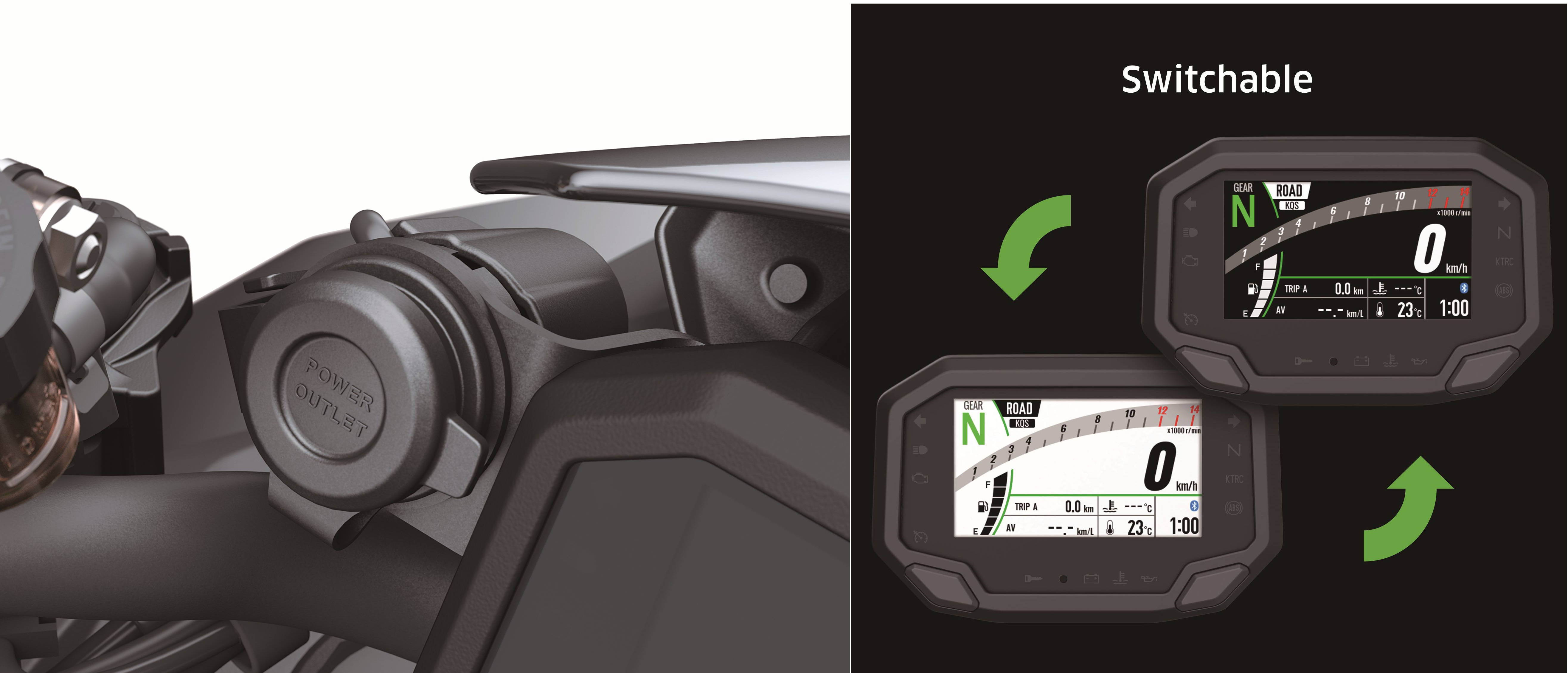
Electronics & Rider Aids
The strength of Kawasaki’s cutting-edge electronics has always been the highly sophisticated programming that uses minimal hardware to give the ECU an accurate real-time picture of what the chassis is doing and what the rider wants, to best support the rider’s inputs with a natural feel. Using the latest evolution of Kawasaki’s advanced modeling software including input from a compact Bosch IMU (Inertial Measurement Unit), Kawasaki Cornering Management Function (KCMF) monitors engine and chassis parameters throughout the corner to assist riders in holding their intended line through the corner. The Z H2 utilizes the input from multiple sensors to optimize ride quality via the Kawasaki TRaction Control (KTRC), Kawasaki Launch Control Mode (KLCM) and the Kawasaki Intelligent Anti-Lock Braking System (KIBS).
Electronic Cruise Control
The Z H2 is equipped with electronic cruise control, which improves the overall comfort for those long days on the road. The cruise control system enables riders to set and maintain their desired speed with the simple press of a button. Once activated, the rider does not have to constantly apply the throttle to maintain speed. The cruise control helps to reduce ride fatigue when traveling long distances, allowing the rider to relax and enjoy cruising, contributing to a high level of riding comfort.
KQS (Kawasaki Quick Shifter)
The Z H2 features a highly reliable contactless-type quick shifter that allows for ultra quick, full power upshifts and seamless acceleration. The system detects that the shift lever has been actuated, and sends a signal to the ECU to cut ignition so that the next gear can be engaged for clutchless shifting.
Power Mode Selection
Riders can set power delivery to suit conditions and/or preference, choosing from Full, Middle and Low. Middle Power is 75% of Full Power, while Low Power is 50% of Full Power.
Styling
The styling of the Z series flagship Z H2 has been shaped according to Sugomi design concept and the minimalist bodywork that Kawasaki’s Z series lineup of motorcycles is known for. Sugomi describes the unique aura that radiates from beings possessing compelling presence and unrivalled power. Featuring a low crouching stance and the asymmetry of the air intake duct installed on the left side of the vehicle body, the Z H2 intensely and aggressively emphasizes the identity of Sugomi design. Only the air intake duct and the under cowl are asymmetrical, all other design work represents accurate symmetry, giving the Z H2 a well-balanced and highly harmonious design.
The supercharger housing is visible from the outside thanks to the naked model concept that does not have a cowl covering the motorcycle’s body. Providing a glimpse of the supercharger between the frame makes for a more impressive appearance.
The Z H2 is equipped with an LED headlight and taillight. The bulbs low power consumption and high durability improve maintainability while providing high-light intensity and high illumination. A clean headlight beam spread contributes to visibility of the rider’s surroundings. The frame-mounted headlamps also influence the styling around the front and create an innovative look that is different from previous naked models.
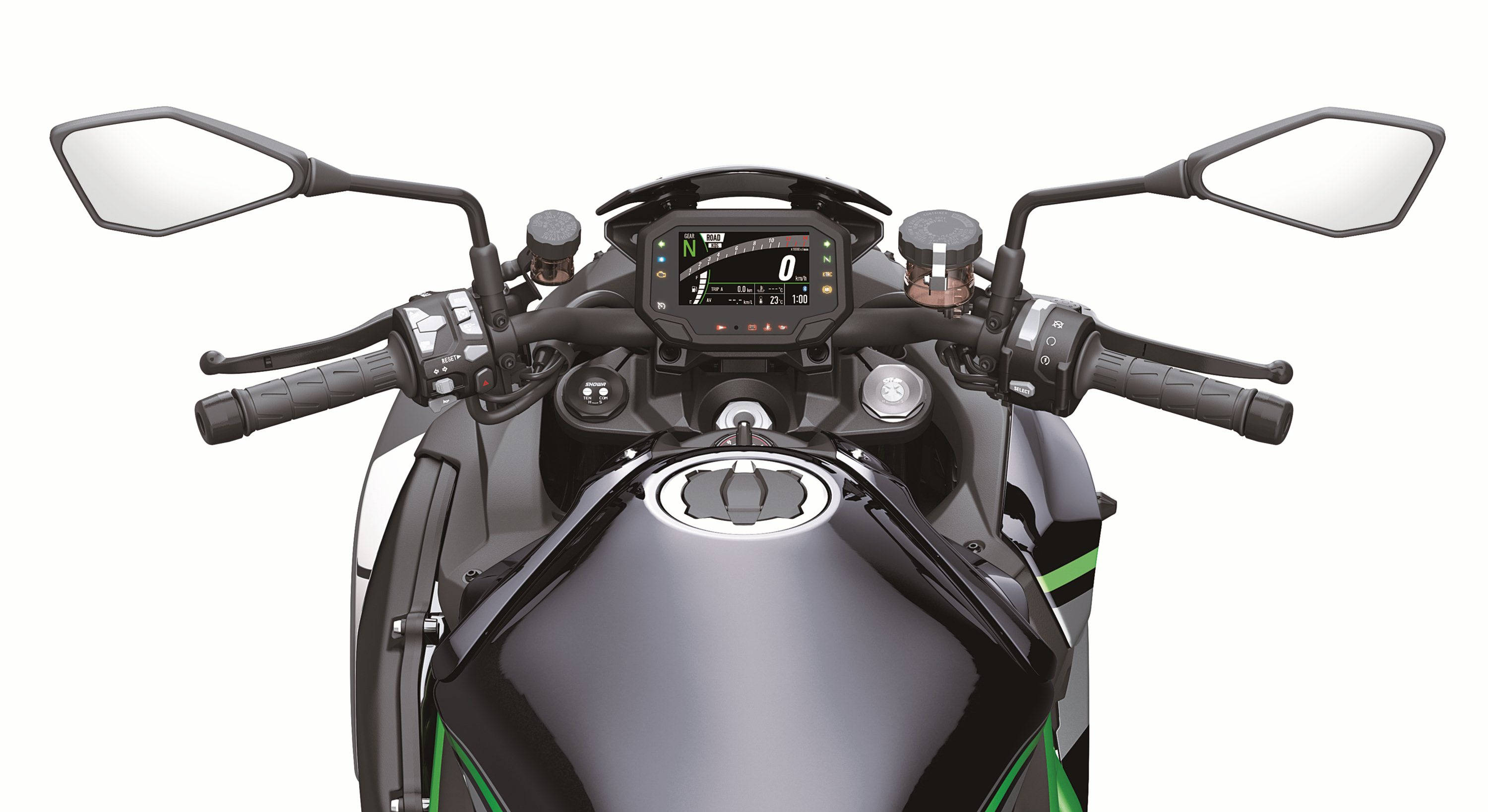
TFT Color Instrumentation
The 4.3” all-digital TFT color instrumentation gives the cockpit of the Z H2 motorcycle a high-tech, high-grade appearance. The full-color display features TFT (thin-film transistor) technology and delivers a high level of visibility. Display functions include: digital speedometer, gear position indicator, shift indicator, odometer, dual trip meter, fuel gauge, remaining range, current/average fuel consumption, outside temperature, coolant temperature, clock, Economical Riding Indicator, IMU indicator, KIBS indicator, boost pressure and boost temperature.
Smartphone Connectivity
Kawasaki continues to offer its Z lineup the addition of Smartphone Connectivity. A chip built into the instrument panel enables riders to connect to their motorcycle wirelessly. Using RIDEOLOGY THE APP*, a number of instrument functions can be accessed, logged, and reviewed contributing to an enhanced motorcycling experience. The following information can be viewed:
1. Vehicle Info
- Check latest status update
2. Riding Log
- Can be logged in detail, and played back for review
- Route, Distance & Time traveled can be logged for review
- Riding conditions can be recorded in detail
3. Telephone Notifications
- Provides a notification on dash when a call or mail is received by smartphone
4. Tuning
- General instrument display setting changes can be made on your smartphone
- Kawasaki Riding Management modes can be set
The app can also be used when away from the motorcycle. When riding (with the app ON), the bike and smartphone are always connected and riding log data is being recorded by the app. After ride is complete, the latest riding information is stored by the app and may be viewed on the smartphone. Any changes made via the app while the engine is off, or while out of range, will be implemented as soon as the ignition is turned on and the smartphone is in range with the app ON.
* RIDEOLOGY THE APP is not intended for use during vehicle operation. Only use RIDEOLOGY THE APP when the vehicle is not being operated and it is safe to do so.
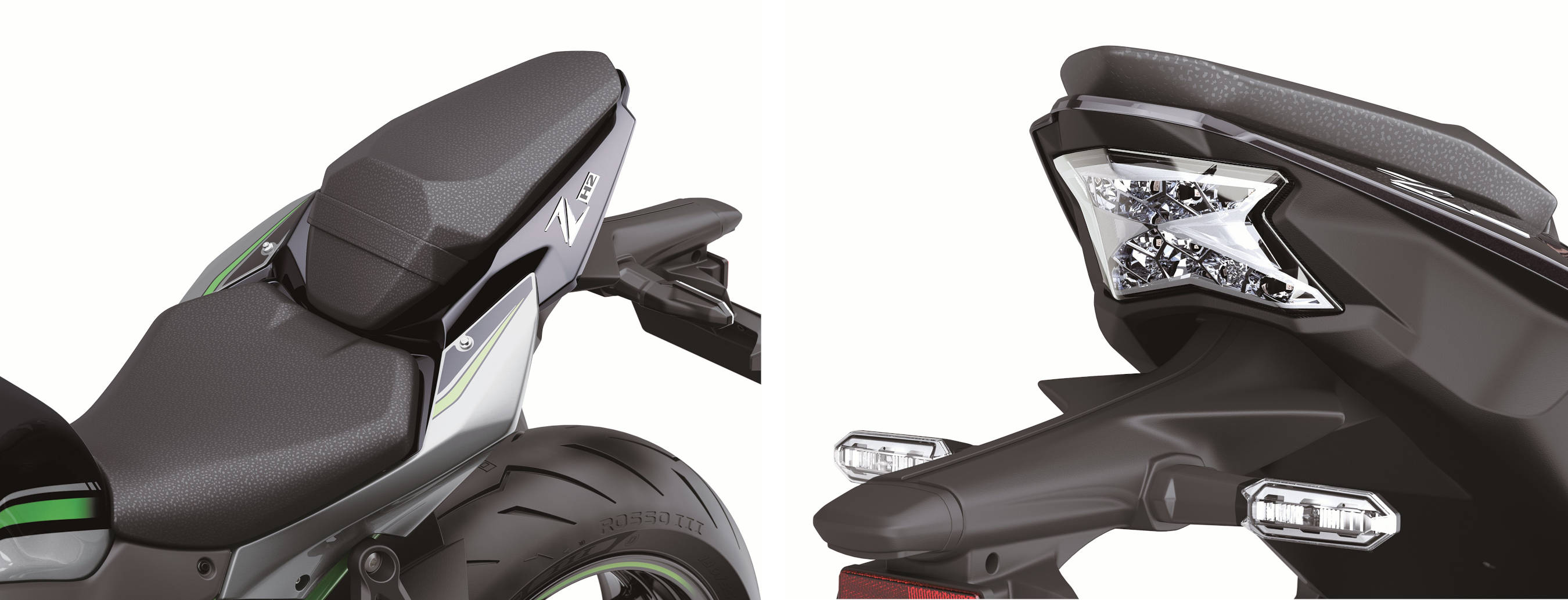
Colors
The 2020 Kawasaki Z H2 is available in:
Metallic Spark Black/ Metallic Graphite Gray/ Mirror Coated Spark Black
MSRP
$17,000






So basically the same weight and torque as a 20 year old ZX12R…
Recently saw this comment about the KTM X-Bow, but it’s also a great tribute to “twitchy” bikes:
It’d be exhausting and stressful if it wasn’t so much fun.
sooo…there’s going to be a moderne-retroey version of this inspired by the ZRX1200.
right?
If I am to bother with a supercharged liter bike, especially one as ugly as this, that better be 200hp at the wheel.
200 HP bike with no fairing protection makes no sense.. Its an amazing moto tho..
Makes no sense to me either, but if that’s what they want…
Sadldebags?
Chip. Nota Ducati
Obviously an incredible motorcycle. I love the styling. Having said that if I were to buy a naked Kawasaki I would buy a Z900 over the ZH2 all day long. You could make much more use of the motor with the 900 in every day use which equates into more fun. Plus 526 lbs wet is a little portly for a naked bike.
I have had a K1300S for 7 seasons. Don’t get me wrong, it is a great bike and I guarantee you that it will be more composed than the ZH2 at high speed however in every day use I rarely hit redline on it. Over 7500rpm it is crazy. I certainly feel like the king of the highway on it and super cool when I pull to an intersection however you don’t need all of that power to have fun, and fun is what it is about for me.
Bikes like this say in a big way, “BECAUSE I CAN !” and need to exist so that other bikes can say “on second thought, what was I thinking?”
It’s grown on me a little, but I still think the very low frame-mounted fairing (on a “naked” bike?) looks dorky. I really think the Kawasaki stylists need to lay off the acid a little.
So what is this ‘Balanced’ concept they are repeating at every opportunity? Is it related to balance shafts, or merely that they think they’ve done something really clever by tuning a motor for some bottom- and mid-range power, instead of only top-end? I can think of plenty of other bikes I’d rather ride for their engine characteristics, and virtually any other bike for the appearance!
Nick: The “Balanced” concept as explained by Kawasaki means a focus on fuel efficiency and power, vs just outright power as in the original H2. My 2018 H2SXSE will get 45 MPG, but that requires judicious use of the throttle.
Real good piece of performance and technology. But so ugly, not even sure is mother could love it !
I will not buy.
Hey Kawasaki, bring back the ZRX, put the ZX14R engine in it, et voilà !
Man, people are different, I guess.
I’d die for a ZX-14R (Best ergos in bikes) with a less overpowering engine, like the one in the ZRX…… Shrink the exhaust cannons on the 14 enough to fit a close mounted set of factory bags, and we’ve got the perfect sport tourer.
I guess it depends on how you define “sport tourer”. The ZX-14R bike is too big and heavy for my needs, not to mention typically Kawasaki ugly. That description also applies to this new ZH2 – too heavy and ugly. Ducati’s Streetfighter will eat it alive.
Anybody who has been reading your comments knows that you see the world through Ducati colored glasses. You are always very biased towards that one brand.
If I’m biased it’s toward European bikes in general. I HATE Japanese design executions – they look like Transformers or angry insects. Yes, I’ve owned several Ducatis, but also a BMW, a Moto Guzzi and an MV Agusta along the way. No matter, as this Kawasaki is still ugly.
I’m pretty partial to the BMW K75S when it comes to sport touring. The ergonomics are perfect for me and all day comfort. The bike will run a couple hundred thousand miles without much maintenance or any repairs. It has surprising acceleration on the highway and very stable deep angle cornering in the twisties although it feels somewhat top heavy. I’ve ridden other sport touring bikes but I only think the the VFR800 comes close to the perfection of the BMW (except for the whole maintenance and repair thing). Everything else has focused too much on power and has become a giant mass of expensive gimmickry.
Try the Ducati SuperSport, which does much of what the VFR has always done.
Some of us don’t enjoy being stranded in town, let alone when touring.
Didn’t you get the memo? Ducatis haven’t been “unreliable” for the last decade or so and their maintenance intervals are on par with the competition.
I’ve ridden both the SS750 and the ST4S. I agree, the SS was a pretty good bike but not much for a comfortable sport tourer. I was hoping the beautiful ST4S was more so but the engine made my legs feel like they were about to burst into flames. I owned a Monster 900 and wasn’t impressed with the handling and didn’t care for the ergonomics, vibrations, or all the noise.
When did that happen? lol
My son has not had that experience with his 2009 696 Ducati Monster..electrics went out, transmission locked up, persistent oil leak, persistent rear brake issue.
Honestly he won’t ride it more than 25 miles one way from his house. If his wife hadn’t bought it for him brand new as a wedding present it would have been gone a long time ago. If he wants to ride further he takes his Yamaha MT-10.
I’ve only known 3 people who have bought Ducati’s in the last few years including my son. The other two traded them off for a Triumph and a KTM after persistent issues with their Ducs. a 796 Monster and a Multistrada.
just found out my buddy that had the Duc and traded it in on the KTM due to issues, has now traded the KTM in on a Moto Guzzi due to issues with the KTM.
Euro bikes…. He’ll never learn lol
I’m a stubborn learner myself, Mickey. But I at least learned over the years to keep a comparable Japanese bike in the garage alongside the Euro so that I always have something to ride!
Well, actually, I’m breaking my own rule right now since the Husqvarna and Beta have no backups. So maybe I haven’t learned that much.
Claiming a curb weight is nice. I wonder if it is accurate. The street bike industry has such a long history of dishonest weight figures that it is going to take a while to gain any trust.
I wonder how long these bikes will be produced. The supercharger is a pretty neat piece of equipment. But the bike as a package doesn’t seem to have any stand out qualities. I’m sure the bike has a wider power curve than it might otherwise have. But it’s a pretty heavy bike. Does it have a wide enough power band to overcome the weight penalty?
What if the next guy were to exercise the same care taken when Kawasaki designed the supercharger to make their liter bike 100 or more pounds lighter. Nothing exceeds like the lack of excess.
Weight makes a bike more comfortable when venturing off the pooltable. It also lessens the effect of a pillion and/or luggage.
Outside of the US, “Big Bikes” like these are fairly popular. Powerful, torquey, ergonomically roomier and less caffeinated in demeanor than smaller “street fighters” and their ilk. In the US, it seems those who want those qualities, buy a gigantic cruiser. But in places where those just don’t fit, “Big Bikes” like these fill the void quite well. Arguably better, even.
I agree that a little weight makes a bike more stable as long as its not so much weight that it retards necessary handling. After all, it’s not a track bike, it’s a street bike. I wouldnt consider 525 pounds (or 550 pounds for that matter) excessively heavy for a well designed 2 up liter bike with this kind of power.
I would consider sub 400 pounds too light for the same purpose.
Your contention – that a bit more weight on a 2 up liter bike is OK – has some merit, as it can then better cope with windy conditions, affords more stability over bumps and better deals with the added weight of a passenger; however, I fail to see this bike as a 2-up tourer – it’s a naked bike with a bulked-up engine. Kawasaki has another supercharged machine for those who tour.
Well, I did say 2 up liter bike (not tourer) and looking at the pictures above it has a passenger seat and rear passenger pegs so I assume it’s designed for street riding 2 up.
More weight on a 1 up bike has merit as well, off the pool table. For one, you can move around a bit without doing an inadvertent U-turn. And a slight windgust from the front won’t immediately stop you dead in your tracks.
Also, having some sprung weight between you and the suspension to brace suspension forces against, instead of having an Italian surgeon screw the top of the springs directly to the bones in your hands, ass and feet, makes for a more comfortable ride when traversing America’s current network of potholed too-crude-to-be-called-cattle-trails at anything above walking pace.
My personal street bike is a sub 300 pound supermoto and my two up rig is a 2004 Multistrada. At around 440#, I consider the Multistrada to be a heavy pig.
I totally reject the idea that weight has any practical use at all. Not for wind or bumps or anything. My sub 250# dirt bikes have no issues with wind and can swallow huge bumps. My sub 130# electric? Still no issues. My sub 30# mountain bikes? Nope.
Every two wheel conveyance that I have ever had the pleasure of riding would only benefit from less weight. In my 52 years of riding motorcycles I have never once wanted one of them to weigh an ounce more.
I agree. My 330 pound Duke 690 is very fast and stable on the highway. However, its fairing-less sit up design is less than ideal. My 500 pound BMW is more affected by winds on the highway, I attribute that to the large fairing.
All I can say is having an equal amount of experience, that I find ultra lightweight bikes twitchy and unstable. When I ride my nephews 690 duke KTM all you have to do is twitch your nose, shift your head, let go with one hand, and the bike is all over the place. Constant vigilance and correction.
I assume you have bought the types of bikes that please you and that you feel comfortable riding, while I have done the same, and that mine weigh more than yours.
Mickey, what you consider “twitchy and unstable” is something you get used to. I like twitchy bikes because they are quick to respond to rider inputs. A twitchy bike is a quick steering bike. One review I read about the 690 Duke said the bike is so responsive it feels like you only have to think about going around a corner and it does it. It’s a great bike for aggressive riders.
I should have explained that better. I didn’t mean you get used to sitting on a bike that is twitching and unstable. I mean, you sharpen your reactions to control the bike better and ride it without it being twitchy and unstable.
If you look at any Iron Butt rally results, there are precious few 250 pound dirt bikes among the top finishers. Precious few 690 Dukes as well.
And that despite those guys benefiting massively from bikes which handle well (collecting bonus points, while not requiring quite Isle of Man levels of aggression, greatly benefits from going “a bit” faster than the average rider…). Yet that other requirement, that of not wearing the rider out too badly over the course of the event, lead most riders to pick FJRs, Big Beemers, Gold Wings etc.
For people not racing for time during their long distance travel, overfocus on “handling” during “aggressive” riding is even less necessary.
Not saying that makes it in any way “wrong” to prefer tight road responsiveness/”twitchiness” over more calmnes, but you are paying for the “twitchy”/quick handling in other areas. Otherwise, Honda would just put a fairing on a dirt bike, and call it the Gold Wing.
Yeah, I wouldn’t consider the Duke twitchy or unstable. It is very quick to respond and telepathic. You feel very much in control of the bike, not at all like wrestling around the big Concourse and the like.
If you want a ‘cushy’ ride you’ll like heavier bikes. If you want good handling, acceleration and agility, weight is your enemy. It’s your choice.
If you want a ‘cushy’ ride you will like heavier bikes. If you want good handling, acceleration and agility, weight is your enemy. It’s your choice.
I suppose a lot depends on how much and what type of roads you ride. Highly technical roads? I could see where light weight and responsive telepathic handling could be an advantage. Sharp turns, blind rises, decreasing radius turns, Sure. Flat straight roads or interstates, not so much. Lazy country curvy roads,not so much either. You can only use so much telepathic handling on a road where sight lines, traffic and leos limit speeds to where those attributes don’t come into play, and where there is no real advantage over a bike with more weight, and less razor sharp handling. There are plenty of guys that can ride 525 lb street bike just as fast as guys can ride 375 pound street bikes where I live because the roads and conditions allow it. If you just like lighg weight bikes, that’s fine, but you wont ride them any faster, and maybe slower, here in the midwest.
Years ago, like everybody else, I believed in “bigger is better.” But as speed limit enforcement got heavier and tougher the opportunities to use big hp and high speeds diminished. I still own a bike with 1000cc and 145hp, and I love it. But I’m aware of its handicaps, particularly that I can’t use all of its power, even in first gear, without risking a speeding fine. They won’t allow us to use big hp and high speeds, but we can still make full use of light weight and agility. It’s a lot of fun and it makes you a better rider.
“Naked” bike with head light surrounded by plastic (fairing?) and bolted directly to the both sides of main frame? This “Sugomi” desingn is kind of tortuous.
Thank you Dirck for posting this additional information. The more I read about the ZH2, the more I like about it. I’m looking forward to your ride report.
Likes: Supercharged Engine, Kawasaki Green trellis frame, standard (meaning comfy) riding position, claimed focus on overall long-distance comfort, designed intake roar, TFT screen, price (least expense supercharged bike in Kawasaki’s lineup), and the focus on increased low-end power. Even the design is growing on me.
Concerns: Weight (60 pounds heavier vs a Yamaha MT10, even heavier vs the new Ducati Streetfighter), the seat height at almost 33 inches might rule out shorter riders, and that seat slant towards the tank and it’s thinness could spell quick discomfort.
I’ve got a 2018 Kawasaki H2SXSE in the garage. The supercharger power doesn’t make itself known until 6k RPM. Otherwise, I love everything about it. The chart in the article shows increased torque from about 2K RPM over the H2SXSE, assuming torque and horsepower cross over at 5252 RPMs. If true, this engine could be ideal, making the overall package of comfort and power irresistible.
Long-haul comfort from a naked bike? That’s not possible with the wind blast at speed.
You need to toughen up. It’s been done many times by many people, including myself.
Yes, I’ve also ridden long distances on naked bikes, but I wouldn’t say it was comfortable.
If you ride a naked with a properly narrow and turned in handlebar, and stable, chosen for high speed long distance, geometry; AND dress appropriately, meaning tight fitting, arms-turned-in-for-riding-not-walking, stiff, heavy, traditional, leathers (Vanson Sportrider sized tight, or even better: Pre-armor tight leather) and a well fitting helmet, you’ll be fine. Leather grips all surfaces really well, keeping you from being moved. Tight fitting, turned in shoulders keep you narrow and, along with stiffness, prevents wind hooking your arms, and rest of body, from resulting in small steering inputs.
If, otoh, you’re on a bike with geometry and ergonomics “responsive” enough to (wide, flat bar etc…) require a steering damper to go straight down the road; while wearing flappy, loose fitting, oversized textiles with 8os era shoulder pads turning you into a modern rendition of a “square rigger by Klim”; and a globe sized modular helmet; things do get a bit tougher.
Years ago I rode long distances on naked bikes at 90-100mph. Never worried about wind blast. Uncomfortable seats were the biggest problem, but I’d tough it out and only stop when I needed fuel. Now we can’t get away with doing that, so wind blast is not a problem. People are getting soft. Toughen up, princess!